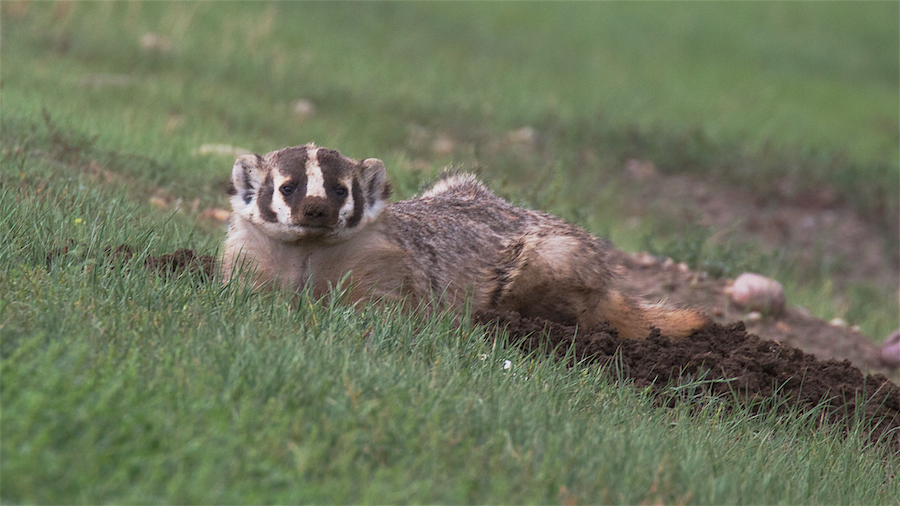Grasslands National Park has always been one of our favourite places to visit. This was our third visit over 20 years. The wide open spaces, Buffalo, Rattlesnakes, Prairie Dog towns, Sharp-tailed Grouse and other birds form a source of attraction for us.
 |
| The Park is on the southern border; adjacent to Montana. There are 2 blocs; east and west. This was the first time we visited both blocs. The west bloc is mostly rolling prairie grass hills while the east bloc resembles badlands. |
In the west bloc we camped at Frenchman Creek Campsite. There were 6 RV's here and 3 of them were popular Escape trailers-made in Chilliwack. Ours is on the right.
We were driving through a Prairie Dog town one evening when I noticed a geyser of dirt been thrown up from a dog hole. We pulled over and this badger popped out. It went back down the hole and continued digging. Every time it backed out I took a picture.
 |
| Out of the corner of my eye I saw another badger approaching. Look at the claws. |
 |
| It was running towards the hole where the other badger had appeared. |
When it got to hole where the other badger had been digging, it stopped and peered in.
 |
| Then it ran to another hole. |
 |
| This was the last shot of it before we returned to the original hole thinking we would wait until the badger that went down there would eventually emerge. We waited about 15 minutes before we realized it wasn't coming out and the original badger must have travelled underground and came out of another hole undetected by us; then returned to its original hole to see if it had scared a Prairie Dog out. |
 |
| We were not sure if this Black Tern was feeding a young one or performing a mating ritual as they both looked like adults. |
Years ago when we first visited the park, there were no Buffalo. 71 were introduced in 2006 after being absent for 120 years. Now there are over 300. Having reached the park capacity, some will be harvested and the meat sold.
 |
| Bobolinks are common here. |
 |
| This Brown Thrasher was in the East bloc. The east bloc is 170 kilometres and 2 hours from the west bloc. |
A Wilson's Snipe taking a break from winnowing.
Eastern Kingbird in east bloc.
 |
| This family of gophers was at our campsite. It was nice to sit back in a camp chair with a beer and watch them. I didn't miss TV. |
 |
| Grey Partridge at the east bloc. They seemed to be common here but not easy to get a picture of. When I was kid growing up in Northern Alberta they were called Hungarian Partridge because they were introduced from Europe. |
 |
| Horned Larks were common in both blocs. Horned Larks vary in color across North America. Some arctic-breeding birds have little or no yellow on the head, while Eastern and south Texas breeders have the head extensively yellow. |
 |
| I am always fascinated by the appearance of shorebirds, like this Long-billed Curlew, in the prairies. |
 |
| Marbeled Godwits are another shorebird that breeds on the prairies. |
While walking around the campsite in the east bloc this male Northern Harrier kept circling me. There must have been a nest nearby.
 |
| A Black-tailed Prairie Dog. |
 |
| If one gets out before sunrise one can sometimes get photo ops with Sharp-tailed Grouse. |
 |
| These Grouse where in the same location when we visited about 15 years ago. |
Common Nighthawks are common. They like to perch on rail fences and are quite approachable.
 |
| Another sandpiper type bird. This one is an Upland Sandpiper. |
We took long hike in the east bloc. Hiking is the only way to explore this section as there is no road through it. We spotted about 25 grouse. We were hoping they may be Sage Grouse which are becoming rare in Canada. There were only about 100 birds in 2012. However they were very spooky and the best shot we got was not conclusive.
 |
Can you spot the 2 heads sticking up?
End of this blog. Scroll down for previous blog.
|






















































